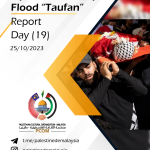Human Rights Watch stated, in conjunction with the release of a document on white phosphorus, that Israel’s use of white phosphorus in military operations in Gaza and Lebanon poses a serious and long-term risk to civilians. Human Rights Watch examined videos taken in Lebanon and Gaza on October 10 and 11, 2023, respectively, showing multiple airbursts of white phosphorus artillery over the port of Gaza City and two locations along the Palestinian-Lebanese border. They conducted interviews with individuals who described the attack on Gaza.
White phosphorus, which can be used for marking, signalling, obscuring vision, or as a weapon to ignite fires that burn people and objects, has a wide-reaching impact, causing severe burns and long-lasting suffering. Its illegal and indiscriminate use in urban areas with high population density, as seen in Gaza, exacerbates the risks faced by civilians and violates the prohibition imposed by international humanitarian law on unnecessary civilian harm.
According to Lama Fakih, Middle East and North Africa director at Human Rights Watch, “Each time it is used in densely populated areas, white phosphorus poses a significant risk of causing painful burns and lifelong suffering. When white phosphorus is illegally airburst in populated urban areas, it can burn homes and cause serious harm to civilians.”
On October 11, Human Rights Watch conducted a phone interview with two individuals from the port area in Gaza City who described witnessing strikes consistent with the use of white phosphorus. One of them was in the street at the time, while the other was in a nearby administrative building. Both described continuous air raids before seeing explosions in the sky, followed by what they described as white lines descending to the ground. They estimated that the attack occurred between 11:30 AM and 1 PM. They both described a choking smell. The person in his office said the smell was so strong that he went to the window to see what was happening and filmed the strike.
Human Rights Watch reviewed the videos and confirmed that they were filmed in the port of Gaza City and identified the munitions used in the airstrike as 155mm artillery white phosphorus shells that airburst. Other videos posted on social media and verified by Human Rights Watch show the same location. Dense white smoke and a strong garlic-like odour are characteristics of white phosphorus.
Human Rights Watch also reviewed two video clips dated October 10 from two locations near the Palestinian-Lebanese border. Both show airburst 155mm artillery white phosphorus shells used apparently as smoke screens, signals, or markers.
White phosphorus ignites upon contact with atmospheric oxygen and continues to burn until deprived of oxygen or consumed. Its chemical reaction can generate intense heat (about 815 degrees Celsius), light, and smoke.
Upon contact, white phosphorus can burn people thermally and chemically, even reaching the bone because it is highly soluble in fat and, therefore, in human flesh. White phosphorus fragments can worsen wounds even after treatment and can enter the bloodstream, causing multiple organ failure. Burns previously dressed can reignite when dressings are removed, and wounds are re-exposed to oxygen. Even relatively minor burns can be deadly. For survivors, extensive scarring can tighten muscular tissue and cause physical disabilities. The shock of the attack, the painful treatment that follows, and the changing appearance of scars can lead to psychological trauma and social exclusion.
Human Rights Watch stated that Israel’s use of white phosphorus in densely populated areas in Gaza violates the duty to take all feasible precautions to avoid civilian harm, as stipulated by international humanitarian law. This concern is exacerbated by the technology shown in videos of airburst white phosphorus shells. The explosion of airburst white phosphorus shells scatters 116 burning fragments soaked in the substance across an area with a diameter ranging from 125 to 250 meters, depending on the height of the explosion, thereby exposing more civilians and civilian structures to potential damage compared to ground-based localized explosions.
Israel’s use of white phosphorus comes amid a brutal aggression on the Gaza Strip since October 7, killing more than 8,000 martyrs, including 3,324 children, 2,062 women, and 460 elderly, in Israeli barbaric airstrikes. Additionally, 20,242 civilians were injured to varying degrees. Israeli occupation forces cut off electricity, water, fuel, food, and internet access to Gaza, in violation of the prohibition imposed by international humanitarian law on collective punishment, worsening the deteriorating humanitarian situation in Gaza under more than 16 years of Israel’s suffocating siege.




